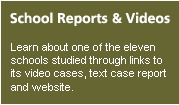|
|
 |
|
||
 |
  |
|||
|
|
|
|||
| Project Overview The intention of the “Exemplary Technology-Supported Schooling Case Studies" project was:
|
 |
|||
| Six site selection criteria were developed with the assistance of a national
advisory group and researchers in the U. S. Department of Education. The site
selection process was arduous, and included input from many experts, diverse
organizations, and searches of publications, databases, and websites. Many
weeks were spent interviewing key personnel at candidate study sites,
reviewing school documents, and discussing each
proposed study site with our advisors. At each of the eleven sites selected,
two researchers spent a week interviewing staff, students, and parents, and
observing several classrooms. (For technical details on the study including
(1) the methods used in site selection, data collection, and analysis, and
(2) a summary of the demographic characteristics of the school sites, view a pdf of the Methodology Report.) The eleven sites in which case studies were conducted included elementary, middle, and high schools. In four of the schools the percent minority was 90% or higher. Four of the schools were located in urban settings and the remaining were situated in suburbs or small towns. In five of the schools over 75% of the students qualified for free or reduced cost lunch. The nature of the innovative and school improvement programs were highly diverse. A case report (available on this website from the School Reports link at left) was prepared for each school site with the intention that teachers and other educational decision-makers would benefit from learning about how schools make technology work for their needs and interests. Multicase reports (available on this website from the Multicase Reports link at left) are being written on various topics to synthesize the wealth of knowledge compiled and integrate it into the ongoing body of educational research conclusions. As more multicase reports are written they will be added to the reports available here. Acknowledgements: This study was funded by a grant from the U. S. Department of Education's Office of Educational Research Improvement, which evolved into the current Institute of Education Sciences. In addition, funds for planning the study were provided by a grant from the National Science Foundation. The views expressed here and in the project reports are those of the authors and not necessarily the sponsoring organizations. International Comparative Study Participation This project investigates innovative cases in the United States, but the research procedures were coordinated with two major international studies. One is the OECD's Organizational Case Studies project and the other is the IEA's SITES-M2 (Second International Technology in Education Study, Module 2). Over 30 countries have been participating in one or both of these studies, each one conducting case studies similar to ours, but with each country determining its own case selection criteria. Selected case results from this project were provided to both international projects.
A preliminary report from eight countries was provided in a symposium at AERA
2002, for which several papers are available the following web page: |
||||
HOME | PROJECT OVERVIEW | SCHOOL REPORTS & VIDEOS | MULTICASE REPORTS | CONTACT |
||||
© 2003 Sara Dexter and Ron Anderson. All rights reserved. Please contact us if you would like more information about the project. | ||||